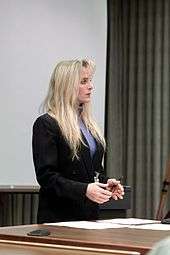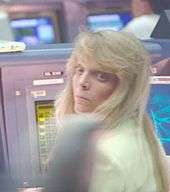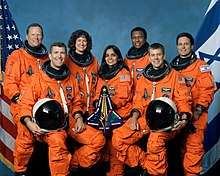Linda Ham
Linda Ham is a former Constellation Program Transition and Technology Infusion Manager at NASA. She was formerly the program integration manager in the National Aeronautics and Space Administration (NASA) Space Shuttle Program Office and acting manager for launch integration. In this position, she chaired the mission management team for all shuttle flights between 2001 and 2003, including shuttle mission STS-107 that ended with the catastrophic destruction of Columbia upon its planned reentry into the Earth's atmosphere.

Ham's actions and decisions, along with those of several other senior NASA managers involved in mission STS-107, were discussed and criticized repeatedly in the official Columbia Accident Investigation Board report, often in the context of management actions, practices or culture that contributed to the disaster. Neither she nor anyone else was individually blamed in the report for the deaths of the seven Columbia astronauts, but she was singled out for exhibiting an attitude of avoiding inspection and assessment of actual shuttle damage.[1] Ham's attitude, and her dismissal of dissenting points of view from engineers, was identified as part of a larger cultural problem at NASA.[2] After the report's release, Ham was demoted and transferred out of her management position in the Space Shuttle program.
Early career
Born as Linda Hautzinger, Ham grew up outside Kenosha, Wisconsin. She graduated from the University of Wisconsin–Parkside in 1982 with degrees in mathematics and applied science. Soon after graduation, at 21 years of age, she applied to and was hired by NASA.[3]
Ham's first position at NASA was as a propulsion systems flight controller at the Lyndon B. Johnson Space Center in Houston, Texas. This was a "back room" position where she offered real-time specialist advice and support to the propulsion engineer, a flight controller in Mission Control. She was soon promoted to the position of propulsion officer in Mission Control itself, the first female to hold that position. In 1990, she married U.S. Navy pilot and NASA astronaut Kenneth Ham, with whom she had two sons, Ryan and Randy. As one of her superiors, Ron Dittemore, later commented, "she had so much talent and her intellect was so strong she could compete with the best in assessing the facts. She rose through the ranks fast at a young age because of her ability to assimilate information".[3]
Ham received her M.S. in Astronautical Engineering from Naval Postgraduate School in 1996 on a NASA fellowship and also an MBA from Rice University in 2006.
Flight director

Ham was the first female to serve as NASA flight director. The first mission she worked as flight director was STS-45, which was launched on March 24, 1992. During her first three missions, all of which took place in 1992, she was assigned to the "Orbit 3" shift.[4] For STS-58, launched October 18, 1993, she moved up to lead flight director. Ham applied for astronaut training herself, but was not selected because of issues with her eyesight.[3]
Ham worked three missions in 1997 and 1998 as the ascent/entry flight director. One of these was STS-95, on which United States Senator John Glenn (D-Ohio) flew as a payload specialist. A week after the flight landed, Ham was caricatured in a Saturday Night Live skit which featured deceased sports announcer Harry Caray as the host of a space and astronomy talk show. Portrayed by Joan Allen, Ham was asked if she invented the Space Shuttle and would like to ride with him to Mars.[5]
In 1999, Ham served as lead flight director on the STS-103 mission. Launched on December 19, 1999, it was technically demanding, involving servicing the gyroscopes of the aging Hubble Space Telescope. "This flight will be a challenge", said Ham before launch, "I can assure you of that".[6] Although challenging, the mission was a success and all its objectives were met.[7]
Manager
In 2000, Ham was promoted into a position in the Space Shuttle Program Office as technical assistant to the shuttle program manager. In 2001, she became the Shuttle program's integration manager, one of six senior managers responsible for Shuttle program operations.[8] In this position, Ham chaired the mission management team (MMT) meetings that oversaw Shuttle flights while in orbit and reported directly to the Shuttle program manager, Ron Dittemore.[9] At the time of the Columbia mission, Ham was also serving as acting manager of Shuttle launch integration, which the Columbia Accident Investigation Board (CAIB) called "a dual role promoting a conflict of interest".[10]
Columbia disaster and investigation report

Mission STS-107, the 113th mission of the Space Shuttle program and the 28th flight of Columbia, lifted off January 16, 2003 from the John F. Kennedy Space Center in Florida on a 16-day dedicated science mission. A large piece of insulating foam separated from the Shuttle's external tank left bipod ramp area 82 seconds after launch and struck Columbia on the leading edge of the left wing.[11] Two days later, after reviewing film of the launch and detecting the foam impact on the left wing, NASA engineers made a request to shuttle program managers for an in-orbit, high-resolution image of the Columbia's left wing to check for damage. The shuttle program managers declined the engineers' request to image the shuttle's wing before reentry.[12]
At 9:00:18 a.m. Eastern Standard Time during reentry on February 1, 2003, Columbia disintegrated over Texas, killing all seven members of its crew.[13] According to one source, a total of three requests were made and rejected for imagery of Columbia in-orbit during the 16-day mission. In addition, the CAIB identified eight missed opportunities to determine the extent of the damage, all of which either got no response from mission management or resulted in no action being taken. The first of these was an inquiry on the fourth day of the mission by the chief engineer of Thermal Protection Systems as to whether the crew had been asked to inspect the damage; no answer was received from lower levels of management. The opinion of the managers that the debris strike was only a maintenance-level concern was established early in the mission, making it increasingly difficult for concerned engineers to be heard by those with decision-making authority. As mentioned in the CAIB report:
In the face of Mission managers' low level of concern and desire to get on with the mission ... the engineers found themselves in the unusual position of having to prove that the situation was unsafe - a reversal of the usual requirement to prove that a situation is safe.
The CAIB report released August 26, 2003 concluded that the physical cause of the destruction of Columbia was damage to the Shuttle's left wing caused by the foam strike during launch.[14] The board also determined that several organizational and human factors contributed to the disaster. These included:
Reliance on past success as substitute for sound engineering practices; organizational barriers that prevented effective communication of critical safety information and stifled professional differences of opinion; lack of integrated management across program elements; and the evolution of an informal chain of command and decision-making processes that operated outside the organization's rules.[15]
It was in the context of these organizational factors that the CAIB discussed the role of decisions made by Ham, as well as by other NASA managers, in contributing to the disaster.
According to the book Comm Check... by William Harwood and Michael Cabbage, some engineers were concerned that the foam strike on the left wing, clearly captured by video recorded during the launch, had caused more damage than initially thought. Based on computer modeling later proven inadequate, Ham's belief was that the damage was not serious and would at most merely lengthen the time necessary to refurbish Columbia between missions.[2] Ham denied requests for high-resolution imaging of the shuttle based on her belief that the damage was too minor to be of consequence.[2] Former flight director Wayne Hale worked outside proper NASA channels in an effort to get imaging of the damage,[16] even though Ham had authority over this decision. In the aftermath of the mishap, Hale was promoted to Space Shuttle Program Manager and then on to NASA headquarters and Ham was demoted.
Ham's on-the-job persona was reported to be somewhat brusque[2] and she was perceived by some below her in the chain of command as being less than willing to embrace dissenting points of view. This was part of a larger cultural problem within NASA which was addressed at length by the CAIB.[2] Even if the hole in the left wing had been discovered immediately, according to flight director LeRoy Cain, there were few if any realistic options to either circumvent the damage or launch a rescue mission, though two realistic options were worked out later.
Aftermath of Columbia investigation
On July 3, 2003, NASA's new Space Shuttle program manager, William Parsons, reassigned three senior engineers who had been involved in the Columbia disaster, including Ham. NASA administrator Sean O'Keefe took the opportunity to praise Ham publicly, saying that the reassignment was "no reflection, in my judgment, on the competence or diligence or commitment or professionalism of anybody...."[17] According to the Washington Post, "O'Keefe said she is so talented there is going to be a 'bidding war' for her among NASA facilities".[18]
Ham's new position was as assistant to Frank Benz, director of engineering at the Johnson Space Center. In December 2003, she served as executive liaison from NASA to the National Renewable Energy Laboratory in Golden, Colorado, where she worked on federal plans for the storage and distribution of hydrogen fuel.[19]
Ham returned to the Johnson Space Center, where she was the technical director for the Constellation Program Office and involved in the major decisions involving the Ares, Orion and Altair vehicles.
She continues her career with NASA as chief of the JSC Partnership Office.
References
Notes
- Columbia Accident Investigation Board, (2003) Volume 1, Chapter 6, p. 138.Chapter 6(pdf). Retrieved April 19, 2017.
- Langewiesche, William (November 2003). "Columbia's Last Flight". The Atlantic. Retrieved February 29, 2012.
- Cabbage, Ex-flight boss
- 1992 JSC news releases
- "Joan Allen: 11/14/98: Space: the Infinite Frontier". Saturday Night Live. November 14, 1998.
- Carreau, Astronauts to make emergency flight to fix Hubble Telescope
- STS-103, Mission Control Center Report #11.
- CAIB, Report of CAIB, Vol 1, p. 17
- CAIB, Report of CAIB, Vol 1, p. 32; Cabbage, Ex-flight boss.
- CAIB, Report of CAIB, Vol 1, p. 200.
- CAIB, Report of CAIB, Vol 1, p. 34
- CAIB, Report of CAIB, Vol 1, p. 38
- CAIB, Report of CAIB, Vol 1, p. 39
- CAIB, Report of CAIB, Vol 1, p. 49
- CAIB, Report of CAIB, Vol 1, p. 9
- CAIB, Report of CAIB, Vol 1, Part 2, p.152
- Sawyer and Pianin, 3 Top Shuttle Managers Replaced.
- Ibid.
- Cabbage, Ex-flight boss.
Further reading
- Starbuck, William H.; Farjoun, Moshe, eds. (2005). Organization at the Limit : NASA and the Columbia Disaster. Blackwell Publishing. ISBN 1-4051-3108-X.
- Cabbage, Michael; William Harwood (2004). Comm check.... Free Press. ISBN 0-7432-6091-0.
External links
- Bradshaw, Fred (June 18, 1998). "Teachers, students track astronaut candidates". dcmilitary.com. Archived from the original on February 10, 2003. Retrieved 2006-07-08.
- Cabbage, Michael (February 1, 2004). "Ex-flight boss reflects on year of lessons". Orlando Sentinel. Retrieved 2006-07-08.- Long article on Ham with biographical information.
- Carreau, Mark (March 11, 1999). "Astronauts to make emergency flight to fix Hubble Telescope". Houston Chronicle. Retrieved 2006-08-24.
- CBS/AP (August 4, 2003). "NASA's Columbia Conversations". CBS News. Retrieved 2006-07-08.-Article discussing NASA management and communication problems that contributed to Columbia disaster.
- Columbia Accident Investigation Board (CAIB) (August 2003). "Report of the Columbia Accident Investigation Board" (PDF). Archived from the original (PDF) on 2006-06-30. Retrieved 2006-07-08.
- Dunn, Marcia (July 23, 2003). "NASA Official Breaks Her Silence". CBS News (cbsnews.com). Retrieved 2006-07-08.- Article about press conference/roundtable with Linda Ham, Phil Engelaug, and LeRoy Cain upon release of accident investigation report.
- Glanz, James; John Schwartz (September 26, 2003). "Dogged Engineer's Effort to Assess Shuttle Damage". New York Times. Archived from the original on November 13, 2012. Retrieved 2006-07-08. - Article discussing engineers futile efforts to ask NASA managers to look into possible damage to Columbia from falling foam during liftoff.
- Kelly, John (1999–2006). "Florida Today Special Report: NASA's Return to Shuttle Flight". Florida Today (Imaginova Corp.). Retrieved 2006-07-08.- Eight chapter analysis of Columbia disaster.
- Kelly, John (August 26, 2004). "Confusion hinders photo effort: Three tries made to get spysat help". Florida Today (Imaginova Corp.). Archived from the original on September 27, 2007. Retrieved 2006-07-08.
- Langewiesche, William (November 2003). "Columbia's Last Flight". The Atlantic Online. Retrieved 2006-07-08.
- National Aeronautics and Space Administration (1992). "1992 JSC News Releases" (PDF). Retrieved 2006-08-24.
- National Aeronautics and Space Administration (December 24, 1990). "STS-103 Mission Control Center Report #11". Retrieved 2006-08-26.
- National Aeronautics and Space Administration (July 23, 2003). "Transcript of NASA press conference/roundtable with Linda Hamm, Phil Engelauf, and LeRoy Cain (part 1)". SpaceRef.com. Retrieved 2006-07-08.
- National Aeronautics and Space Administration (July 22, 2003). "Transcript of Mission Management Team Meeting, Friday, January 24, 2003, 8 a.m. CST, Hosted by Ms. Linda Ham" (PDF). NASA Facts. Retrieved 2006-07-08.
- O'Brien, Miles; Betty Nguyen (July 25, 2005). "CNN Live Today". Cable News Network (CNN.com). Retrieved 2006-07-08.- Transcript of video interview with Linda Ham and others prior to Space Shuttle Discovery mission.
- Oberg, James (2006). "Post-Columbia NASA hunkers down: Officials'view of shortcomings is a bad omen for future clash". NBC News. Retrieved 2006-07-08.- Critical analysis of NASA managers involved in roundtable discussion with press on July 23, 2003.
- Reinert, Patty; Mark Carreau (September 4, 2003). "NASA probers on hot seat: Senators demand: Who's to blame?". The Houston Chronicle. Retrieved 2006-07-08.
- Sawyer, Kathy; Eric Pianin (August 27, 2004). "Report Blames Flawed NASA Culture for Tragedy: In Broad Indictment of Practices, Shuttle Panel Says Safety Suffered". The Washington Post. Archived from the original on May 7, 2005. Retrieved 2006-07-08.
- Sawyer, Kathy; Eric Pianin (July 3, 2003). "3 Top Shuttle Managers Replaced: All Took Part in Key Decisions Leading Up to Columbia Disaster". The Washington Post. Archived from the original on June 29, 2006. Retrieved 2006-07-08.
- Smith, R. Jeffrey (July 13, 2003). "Mistakes Of NASA toted up". The Washington Post. Archived from the original on 2006-06-29. Retrieved 2006-07-08.
- Wald, Matthew L.; John Schwartz (August 14, 2003). "Shuttle Inquiry Uncovers Flaws in Communication". New York Times. Retrieved 2006-07-08.